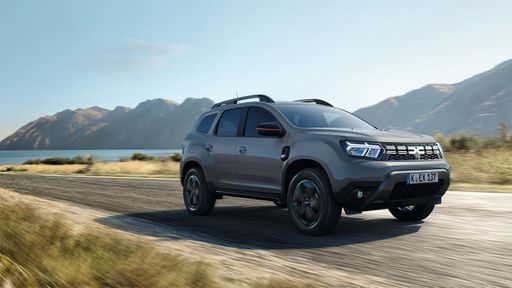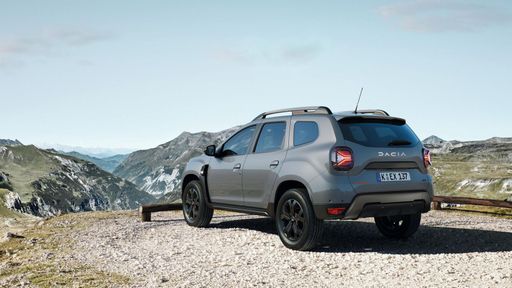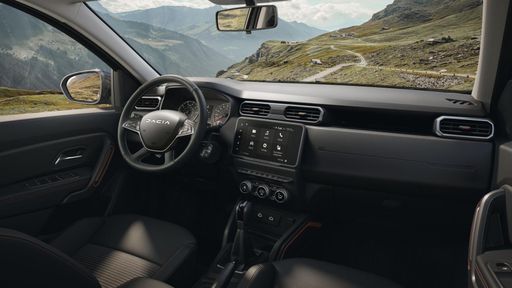The automotive landscape is ever-evolving, and with it comes the introduction of exciting new models designed to cater to diverse needs and preferences. Recently, the Dacia Duster and Omoda 5 have emerged as contenders in the compact SUV market. Both vehicles promise unique attributes, but which one reigns supreme? Let’s delve deeper into a comparison of these two impressive models.
Dacia Duster vs Omoda 5 – Osiągi, zasięg i zużycie w porównaniu
Oba modele mają swoje mocne strony – ale który lepiej pasuje do Ciebie?
Porównaj bezpośrednio osiągi, zużycie, cenę i przestrzeń: Dacia Duster czy Omoda 5?
Design and Dimensions
The Dacia Duster exudes a robust and rugged charm typical of its brand, featuring a solid and muscular stance. With dimensions of 4343 mm in length, 1813 mm in width, and a height of 1656 mm, it offers a commanding presence on the road. Conversely, the Omoda 5 exhibits a sleeker and more contemporary design. It measures 4424 mm in length, 1830 mm in width, and stands at 1588 mm tall, providing a blend of style and practicality.
Powertrain and Performance
When considering powertrain options, the Dacia Duster presents versatility with several offerings, including LPG, full hybrid, and petrol MHEV engines. Power outputs range from 91 HP to 140 HP, with torque varying between 160 Nm and 230 Nm. Its acceleration from 0-100 km/h varies from a respectable 9.9 seconds to a slower 14 seconds, depending on the variant chosen.
In contrast, the Omoda 5 is powered solely by a petrol engine that produces an impressive 204 HP and 290 Nm of torque. It showcases exhilarating performance with an acceleration time of just 7.8 seconds from 0-100 km/h, allowing it to easily outpace its rival in sheer speed. The top speed of the Omoda stands at 220 km/h, significantly higher than the Duster's maximum of 180 km/h.
Fuel Efficiency
Fuel efficiency is an essential consideration for any SUV. The Dacia Duster boasts a range of consumption figures, from a commendable 5 L/100 km to 8.1 L/100 km, ensuring that drivers can select a model that best fits their fuel economy requirements. Its fuel tank capacity ranges from 50 to 55 liters, allowing for extended journeys without frequent stops for refueling.
On the other hand, the Omoda 5 maintains a competitive consumption figure of 7.5 L/100 km with its petrol engine and has a fuel tank capacity of 51 liters. While slightly thirstier than some Duster variants, it makes up for this with its superior power and performance.
Interior and Comfort
Both models are designed to accommodate five passengers comfortably. The Duster, with trunk capacities ranging from 430 to 517 liters, offers ample space for storage, making it a practical choice for families or road-trippers. Its interior is straightforward but functional, emphasizing utility over luxury.
In contrast, the Omoda 5 may come with a more upscale interior design, providing a touch of elegance to the driving experience. However, specific trunk capacity details for the Omoda remain unclear, focusing instead on overall passenger comfort and digital features that enhance convenience.
Innovations and Technological Features
The Dacia Duster comes equipped with a variety of technical innovations, including advanced safety features and an intuitive infotainment system that keeps occupants connected on the road. Depending on the trim level, additional driver-assist technologies may also be available, enhancing both safety and comfort.
On the technological front, the Omoda 5 likely embraces a modern infotainment setup with advanced connectivity options, aiming to compete with the best in class. While specific tech offerings remain to be detailed, the emphasis on user-friendly interfaces and smart technology integration is expected to be a focal point for the brand.
Conclusion
The decision between the Dacia Duster and Omoda 5 ultimately hinges on personal preferences and requirements. The Duster shines with its versatility, efficient engine choices, and practicality, making it a solid option for budget-conscious buyers. Meanwhile, the Omoda 5 stands out in performance and modern design, appealing to those seeking a dynamic driving experience and cutting-edge technology. Whether you prioritize rugged reliability or stylish performance, both models offer compelling choices in the increasingly competitive SUV market.
Szczegóły techniczne: konkretne różnice między modelami
Koszty i zużycie
W kwestii ekonomii oba modele pokazują ciekawe różnice.
Dacia Duster ma przekonujący przewagę cenową – jego cena zaczyna się od 83400 zł, podczas gdy Omoda 5 kosztuje 118600 zł. Różnica wynosi około 35187 zł.
W spalaniu również widać różnice: Dacia Duster zużywa 5 L i jest tym samym przekonujący oszczędniejszy niż Omoda 5, który spala 7.50 L. To około 2.50 L różnicy na 100 km.
Silnik i osiągi
Pod maską widać, który model jest bardziej sportowy i kto ma lepszy start.
Pod względem mocy silnika Omoda 5 ma czytelny przewagę – 204 KM zamiast 140 KM. To różnica około 64 KM KM.
W przyspieszeniu 0–100 km/h Omoda 5 jest oczywisty szybszy – 7.80 s wobec 9.90 s. Różnica wynosi około 2.10 s sekundy.
Pod względem prędkości maksymalnej Omoda 5 jest trochę lepszy – osiąga 220 km/h, podczas gdy Dacia Duster kończy na 180 km/h. Różnica to około 40 km/h.
Różnica widoczna jest również w momencie obrotowym: Omoda 5 ciągnie wyraźny mocniej – 290 Nm wobec 230 Nm. Różnica to około 60 Nm.
Przestrzeń i praktyczność
Samochód rodzinny czy codzienny towarzysz – który oferuje więcej miejsca, komfortu i elastyczności?
Oba samochody oferują miejsce dla 5 osób.
Pod względem pojemności bagażnika Dacia Duster oferuje przekonujący więcej miejsca – 517 L wobec 0 L. To różnica około 517 L litrów.
W maksymalnej pojemności ładunkowej Dacia Duster wypada oczywisty lepiej – do 1609 L, czyli o około 534 L więcej niż Omoda 5.
Kto wygrywa pojedynek?
Dacia Duster okazał się dominuje w porównaniu i tym samym zdobywa tytuł DriveDuel Champion!
W tym porównaniu Dacia Duster to bardziej wszechstronny wybór.

Dacia Duster
Dacia Duster
Dacia Duster to twardy, bezpretensjonalny SUV, który z równą lekkością radzi sobie w miejskim gąszczu i na bocznych, błotnistych ścieżkach. Za niewygórowaną cenę oferuje praktyczność, prostotę obsługi i niskie koszty utrzymania — idealny wybór dla osób szukających sensownego auta bez zbędnych fajerwerków.
szczegóły @ dacia-presse.de
@ dacia-presse.de
 @ dacia-presse.de
@ dacia-presse.de
 @ dacia-presse.de
@ dacia-presse.de
 @ dacia-presse.de
@ dacia-presse.de
Omoda 5
Omoda 5 to zgrabny i stylowy SUV, który przyciąga spojrzenia nowoczesną stylistyką i przestronnym, dobrze wykończonym wnętrzem. Dla kupujących szukających fajnego wyglądu i sensownego wyposażenia za rozsądną kwotę to bardzo kusząca opcja — z przymrużeniem oka dodam, że potrafi udawać droższą niż jest.
szczegóły

|
|
|
|
|
Koszty i Zużycie |
|
|---|---|
|
Cena
83400 - 127300 zł
|
Cena
118600 zł
|
|
Zużycie L/100km
5 - 7.6 L
|
Zużycie L/100km
7.50 L
|
|
Zużycie kWh/100km
-
|
Zużycie kWh/100km
-
|
|
Zasięg elektryczny
-
|
Zasięg elektryczny
-
|
|
Pojemność baterii
0.60 kWh
|
Pojemność baterii
-
|
|
CO2
113 - 148 g/km
|
CO2
-
|
|
Pojemność zbiornika paliwa
49 - 55 L
|
Pojemność zbiornika paliwa
51 L
|
Wymiary i Nadwozie |
|
|---|---|
|
Typ nadwozia
SUV
|
Typ nadwozia
SUV
|
|
Miejsca siedzące
5
|
Miejsca siedzące
5
|
|
Drzwi
5
|
Drzwi
5
|
|
Masa własna
1351 - 1465 kg
|
Masa własna
-
|
|
Pojemność bagażnika
430 - 517 L
|
Pojemność bagażnika
0 L
|
|
Długość
4343 mm
|
Długość
4424 mm
|
|
Szerokość
1813 mm
|
Szerokość
1830 mm
|
|
Wysokość
1656 - 1661 mm
|
Wysokość
1588 mm
|
|
Maksymalna pojemność bagażnika
1545 - 1609 L
|
Maksymalna pojemność bagażnika
1075 L
|
|
Ładowność
414 - 430 kg
|
Ładowność
-
|
Silnik i Wydajność |
|
|---|---|
|
Typ silnika
LPG, Pełna Hybryda, Mild Hybrid Benzyna
|
Typ silnika
Benzyna
|
|
Skrzynia biegów
Manuel, Automatyczna
|
Skrzynia biegów
Automatyczna
|
|
Szczegóły skrzyni biegów
Manualna skrzynia biegów, Zautomatyzowana manualna
|
Szczegóły skrzyni biegów
Automatyczna dwusprzęgłowa
|
|
Rodzaj napędu
Napęd na przednie koła, Napęd na cztery koła
|
Rodzaj napędu
Napęd na przednie koła
|
|
Moc KM
91 - 140 KM
|
Moc KM
204 KM
|
|
Przyspieszenie 0-100km/h
9.9 - 14 s
|
Przyspieszenie 0-100km/h
7.80 s
|
|
Maksymalna prędkość
160 - 180 km/h
|
Maksymalna prędkość
220 km/h
|
|
Moment obrotowy
160 - 230 Nm
|
Moment obrotowy
290 Nm
|
|
Liczba cylindrów
3 - 4
|
Liczba cylindrów
4
|
|
Moc kW
67 - 104 kW
|
Moc kW
145 kW
|
|
Pojemność silnika
999 - 1598 cm3
|
Pojemność silnika
1598 cm3
|
Ogólne |
|
|---|---|
|
Rok modelowy
2024 - 2025
|
Rok modelowy
2024
|
|
Klasa efektywności CO2
D, C, E
|
Klasa efektywności CO2
-
|
|
Marka
Dacia
|
Marka
Omoda
|
Jakie wersje napędu oferuje Dacia Duster?
Model oferowany jest z napędem Napęd na przednie koła albo Napęd na cztery koła.
Wyświetlane ceny i dane są szacunkowe, oparte na niemieckich cenach katalogowych i mogą się różnić w zależności od kraju. Te informacje nie stanowią wiążącej oferty.
